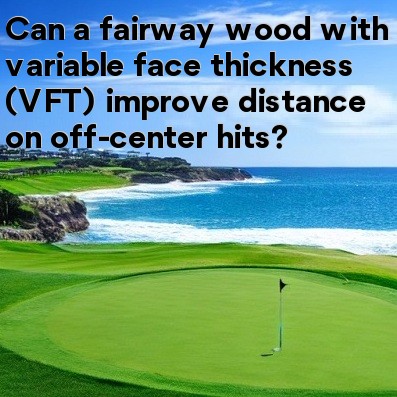
In golf, Can a fairway wood with variable face thickness (VFT) improve distance on off-center hits?
When it comes to hitting fairway woods, golfers often strive for maximum distance and accuracy. One of the technological advancements that has been introduced to fairway woods is the use of Variable Face Thickness (VFT). This innovative design feature is aimed at improving distance, particularly on off-center hits.
VFT refers to the construction of the clubface, where the thickness varies in different areas. Traditionally, fairway woods had a consistent thickness across the face, but with VFT, manufacturers can strategically vary the thickness to optimize performance. The concept behind this design is to promote higher ball speeds and increased distance on mis-hits.
How does VFT work to improve distance on off-center hits? Well, when the ball is struck on the sweet spot, which is the center of the clubface, maximum energy transfer occurs, resulting in optimal distance. However, when the ball is hit off-center, towards the heel or toe of the clubface, the energy transfer is not as efficient, and distance can be compromised.
This is where VFT comes into play. By varying the thickness of the clubface, manufacturers can control and manipulate the flex of the face. A thicker area of the face allows for more forgiveness and less ball speed loss on off-center hits. On the other hand, a thinner area of the face enhances ball speed on center strikes.
By incorporating VFT technology in fairway woods, manufacturers are aiming to create a larger, more forgiving sweet spot. This means that even if you don't strike the ball perfectly, you still have a chance of achieving decent distance. The increased forgiveness on off-center hits can be especially beneficial for amateur golfers, who tend to have less consistent ball-striking than professionals.
Furthermore, VFT can also help to correct the common miss-hits that occur towards the heel or the toe of the clubface. By allowing the face to flex more efficiently in these areas, the technology helps to straighten out shots that would otherwise veer off target.
It's important to note that while VFT can improve distance on off-center hits, it is not a magical solution that will turn every bad shot into a perfect strike. Proper swing mechanics, solid contact, and overall skill still play a significant role in achieving distance and accuracy. However, VFT can certainly be seen as an added advantage that contributes to enhanced performance.
In conclusion, fairway woods with Variable Face Thickness (VFT) technology have the potential to improve distance on off-center hits. By varying the thickness of the clubface, manufacturers can increase forgiveness and ball speed on mis-hits, leading to greater distance. While VFT is not a substitute for proper technique and skill, it can be a valuable tool in a golfer's arsenal to optimize performance and enhance their overall game.





